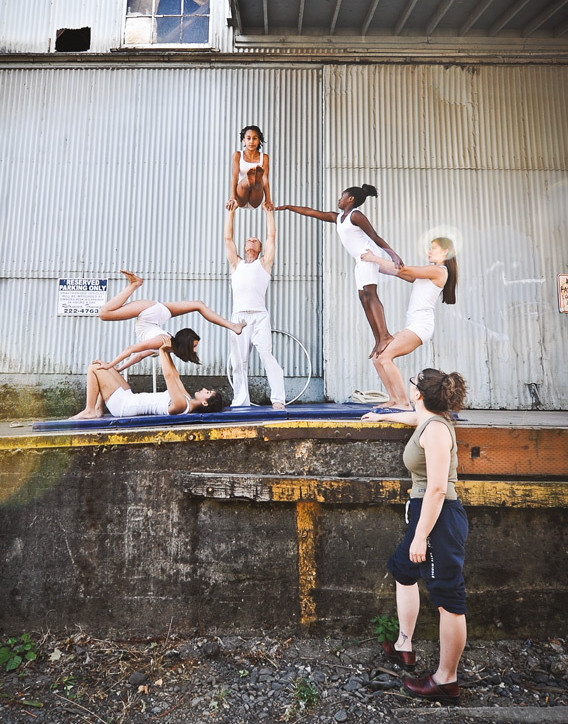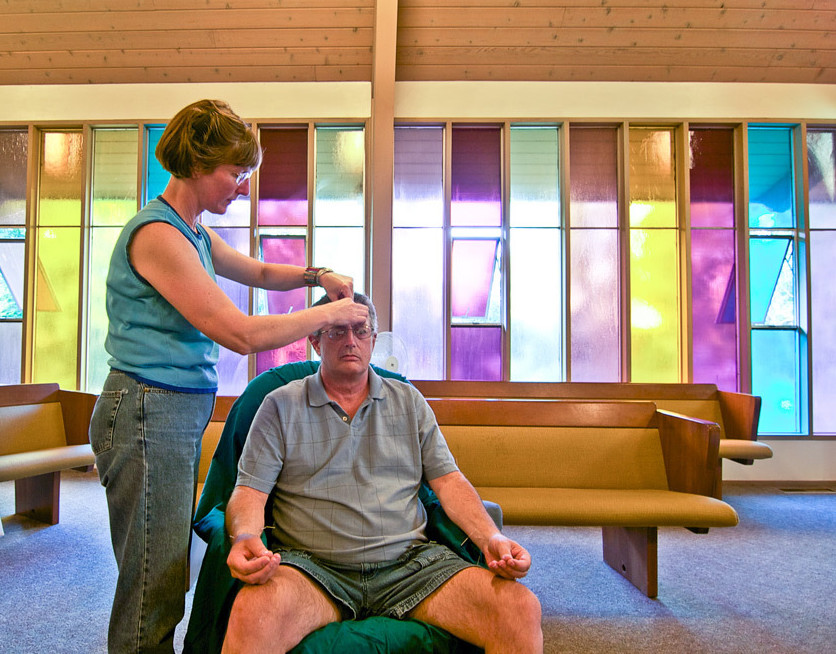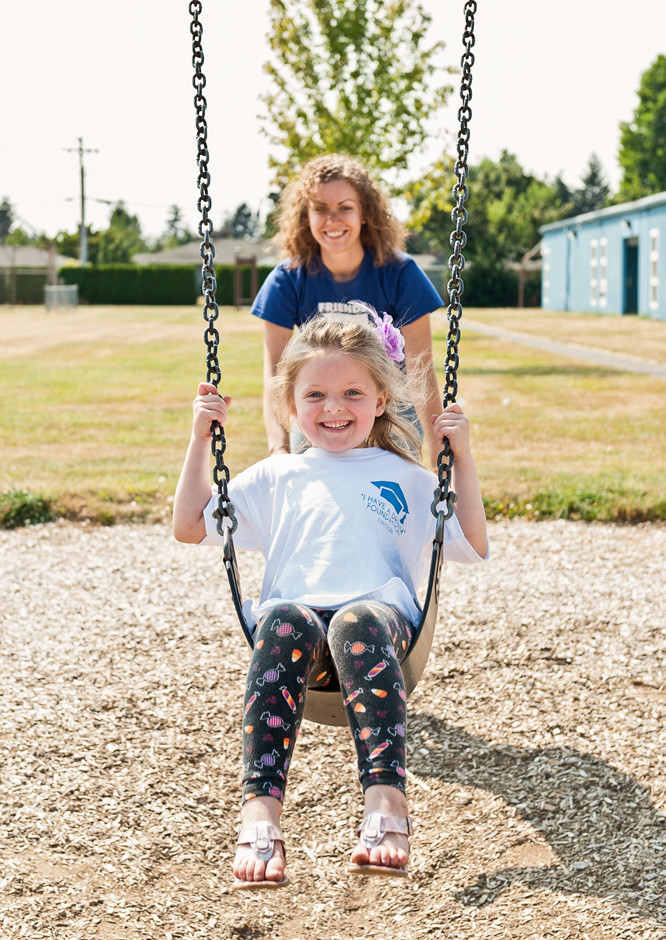Light A Fire 2012

Keeping Us Healthy | Awarded to an organization that helps us take care of ourselves
Outside In
Impact at a Glance
Patients Treated In 2011
17,000
Percentage Who Are Homeless
69
Housing Units for Homeless Youth
65
As usual, there are few available chairs in the sunny waiting room of Outside In’s primary care clinic on SW 13th Avenue. Last year nearly 17,000 patients—69 percent of them homeless—flowed through the nonprofit’s medical clinics, a record. But Outside In’s impact on keeping Portland healthy extends well beyond the examination room. “We treat the whole person,” says communications director Kelly Anderson. For instance, because poor nutrition is a serious issue for many of the people it treats, Outside In serves three meals a day, six days a week to homeless youth. To address the lack of education prevalent among that population, Outside In started a school, where in June 17 homeless youth—with the help of one amazing teacher and a lot of volunteers—received their GEDs. Since the nighttime streets harbor threats more severe than just disturbed sleep, some 65 housing units are available for youth ready to make the transition from street life to home life. And because addiction is a persistent problem, Outside In started a needle exchange. Last year the program issued more than 525,000 syringes—and received 99.96 percent of those back—which helps to prevent the spread of diseases that have exorbitant treatment costs and can cut a young life short. One thing Outside In can’t change is the rate of homelessness itself, which has skyrocketed since the economic downturn. From 2010 to 2011, Outside In helped 118 percent more young people than it did just five years before, demonstrating just how essential this nonprofit is to our city.
Growing Creativity | Awarded to an organization working to foster arts and culture in Oregon
THE CIRCUS PROJECT

The Circus Project founder Jenn Cohen—pictured here with current and past students—spends a year training between four and six homeless youths.
Image: Mei Ratz
Impact at a Glance
Year Founded
2008
Number of 2011 Trainees (Homeless Youth)
4
Percentage of 2011 Trainees Now Employed
100
Nineteen-year-old Taylor Coghill just signed a lease on her very first house, a duplex. The day before that, she earned a promotion at the gym where she works. And not long before that, she became engaged. Typical life stuff, really—until you learn that Coghill left home at age 14 and spent four years homeless and backpacking around the country. For Coghill, an articulate, confident, and forthright young woman, these “typical” milestones seem nearly miraculous. Coghill credits her transformation partly to the Circus Project, a four-year-old nonprofit circus performance troupe founded by 36-year-old professional aerialist Jenn Cohen. As part of her nonprofit’s outreach programs (which include free drop-in classes for homeless youth), Cohen, who has also worked as a therapist, spends a year training four to six homeless youths in the rigors of circus performance. But the program teaches much more than, say, how to roll down an aerial silk. “Teaching skills is easy,” Cohen says, standing in the diminutive Northwest neighborhood gym where aerial hoops, ropes, trapezes, and brightly colored silks hang from the ceiling. “Teaching the work ethic is a much, much bigger challenge.” For those young people who stick with the intensive program, the training pays off. All four of last year’s trainees are in housing. All have jobs, and two still work for the Circus Project, running its open gym classes—exactly the kind of result Cohen intended. “It’s more than circus,” Coghill says. “It’s about being accountable to others, respecting others and yourself, taking direction. You can take those skills anywhere.”
Most with the Least | Awarded to an organization doing big things with minimal resources and fewer than five paid staffers
Portland Veterans Acupuncture Project

Dr. Diane Miller (left), one of the founders of the Portland Veterans Acupuncture Project, administers treatments to vets in a small Southeast church every Thursday night.
Image: Mei Ratz
Impact at a Glance
Year Started
2007
Treatments In 2011
1,254
Annual Budget
$4,131
It’s a reality of war: years and even decades after combat, too many service members continue to struggle with war’s devastating effects on their bodies and their spirits. In fact, up to 20 percent of Iraq and Afghanistan war vets and up to 30 percent of Vietnam vets suffer from PTSD or other stress-related ailments. Acupuncture has been shown to help relieve symptoms, yet veterans’ benefits rarely cover the treatment. So when a new generation of soldiers began returning from Iraq and Afghanistan, retired Portland VA Hospital researcher Prudence Marshall, VA doctor Diane Miller, and licensed acupuncturist Rick DeTroy took matters into their own hands, literally. With no website and no budget, in 2007 they rented a small sanctuary in a Southeast church, filled it with lounge chairs, and started offering donation-only acupuncture to veterans every Thursday night. Over five years, the number of veterans the group helps has ballooned. In the first year, the group saw two, maybe three vets a night. Today, it’s more like 25—on a shoestring budget. In 2011, the group administered 1,254 treatments for vets and their spouses and received a mere $4,131 for the effort, an average of just $3.29 per treatment. (Acupuncturists often charge $75 or more per treatment session.) But the scene inside the church provides a testament to acupuncture’s priceless power. After the needles go in, chatter falls away, visible agitation ceases, and arms and legs relax. The relief is palpable—and for veterans like Adam Black, a soldier in Operation Iraqi Freedom and other tours who suffers from PTSD, the weekly treatments are life renewing. “I come in crawling,” he says, “and I leave walking.”
Honoring Our Elders | Awarded to an organization that serves and celebrates the oldest and wisest people in our community
Wisdom of the Elders
Impact at a Glance
Year Founded
1993
Elders’ Stories Captured
300+
Master Storytellers at 2011 Northwest Indian Storytelling Festival
12
Woodrow Morrison Jr., a Native American elder and storyteller from Alaska’s Haida tribe, knows how difficult it is to overcome anger and rage. When he was younger, his method of coping with pain was to fight; as an adult, he continued the pattern by becoming emotionally abusive toward his family. “I was ashamed of myself,” he says. Morrison eventually recovered his spirit. His journey to redemption—which took him to sweat lodges, an Apache therapist, and healing ceremonies—is documented in perpetuity thanks to Wisdom of the Elders. Founded by Rose High Bear and her late husband, Lakota medicine man Martin High Bear, the nonprofit records, preserves, and shares the oral histories and traditional knowledge of indigenous elders (more than 300 since the 1990s)—and uses the stories to help others. “I realized the power of stories to heal,” says Rose High Bear. Morrison’s story, for example, is part of a high school curriculum developed to help Native kids tackle deeply personal subjects rarely covered in a classroom, such as how to avoid and overcome addiction, and the nature of spiritual healing. Wisdom of the Elders also has produced a radio series about Native life, produced a local cable series called Discovering Our Story, and created the Northwest Indian Storytelling Festival. All of it is a way to take Native history and make it very much relevant to life today. “If I put a [traumatic experience] behind me … it’s just going to hit me in the face again,” Morrison says. “But if I let it go, then I can see where it fits into my history, and it starts to make sense.”
Inspiring Our Next Generation | Awarded to an organization doing big things for children
De La Salle North Catholic High School

De La Salle student Calvin Curry (’15) takes notes in his global studies class. The school’s rigorous academics help prepare students for college, where 96 percent of De La Salle grads will end up.
Impact at a Glance
School Population
345
College Enrollment Rate
96%
Annual Tuition
$3,000
You know you’re at a different kind of private school when its president is as proud of the school’s new shower as he is of a recent grad’s full ride to Georgetown University. And De La Salle North Catholic High is anything but typical: Nearly all of its 345 students come from low-income families, and some are so poor or disconnected that the kids don’t even have regular access to a bathroom. The shower ensures that at least one basic need is met. “It’s stories like this that really move me,” says De La Salle president Matt Powell. While most Catholic schools cost more than $10,000 a year, De La Salle’s tuition is less than $3,000. With few exceptions, to attend a student’s family’s income should average no more than about $15,000 per family member. (“We actually have to turn away kids because their families earn too much money,” Powell says.) More than 75 percent of its students receive financial aid. Some of that tuition is made up through the North Portand school’s innovative Corporate Internship Program: once a week, every student works at a paying internship with one of some 80 local companies, including Nike, Columbia Sportswear, and OnPoint. The money they earn goes back to the school—but it also means that by the time these kids leave high school, their résumés are more impressive than those of many college grads, as are their confidence and social skills. Does work detract from the academic program? Hardly. Most students arrive one to two grades behind in math and reading, but 96 percent of them go on to enroll in two- or four-year colleges. “We don’t compromise on the expectations,” Powell says.
Caring for the Planet | Awarded to an organization working to better balance human impacts on the natural environment
Columbia Slough Watershed Council

Last year the Columbia Slough Watershed Council’s Slough School brought more than 6,100 students to the water with events like the Aquifer Adventure, a pirate-themed exploration of the waterway.
Image: Mei Ratz
Impact at a Glance
Year Founded
1994
Hours Volunteered In 2011
1,650
Pounds of Garbage Removed In 2011
3,000
When Lewis and Clark first traveled down the Columbia in 1805, the explorers wrote that they were “kept up during the whole of the night by swans and geese.” But by 1955, part of that floodplain, the Columbia Slough, once rich with wildlife, sat clogged with tires, sewage, and garbage. “It was treated like a dump,” says Jane Van Dyke, executive director of the Columbia Slough Watershed Council. For nearly 20 years, Van Dyke’s group—with the help of thousands of volunteers—has removed umpteen tons of garbage (3,000 pounds last year alone), planted native alder and cottonwood trees along denuded banks, and removed invasive weeds, such as reed canary grass, that can choke out native species. Perhaps even more important, the council has helped restore the slough’s reputation as a vital part of the Columbia River ecosystem. (That has been a challenge, considering that the waterway remains largely hidden behind industrial buildings and homes—feeding an out-of-sight, out-of-mind mentality.) Last year, the nonprofit’s Slough School brought 6,157 students to its waters for science-based field trips, and 2,100 people participated in the council’s annual boat trips, walking and paddling tours, and workshops. Those who ply the slough’s highly managed waters by canoe or kayak today may not hear the cacophony of birds that Lewis and Clark did, but they are rewarded by experiencing what many in Portland do not: a hidden oasis that is home to sensitive species like bald eagles, peregrine falcons, and western pond turtles, all harbingers of a waterway that is on the right track.
Best New Nonprofit | Awarded to an organization that is less than three years old
August Wilson, Red Door Project
Impact at a Glance
Year Founded
2011
Number of Performances
20
Conversations Stimulated
Immeasurable
Cocktails typically cap off a night at the theater. But conversation was the only thing on the menu following Profile Theatre’s spring matinee of A Lesson Before Dying, based on the book by Ernest Gaines. Set in Louisiana, Romulus Linney’s gritty play deals head-on with difficult racial themes—the dehumanization of black people, for instance, and how debasement begets anger and self-loathing. Instead of filing out for a manhattan, though, the audience engaged in a discussion about race, a topic many Portlanders find difficult, even impossible, to talk about. “We wanted to create a space where people don’t feel guilty about their feelings around race, where they could be open, not shamed, and grow from the experience,” says Lesli Mones, who cofounded the August Wilson Red Door Project with her partner and the play’s director, Kevin E. Jones, in 2011. The discussion following A Lesson Before Dying was just one of the talk back sessions hosted this spring by the Red Door Project, which “strives to change the racial ecology of Portland,” a city that historically, geographically, and culturally has kept its citizens of color separated from its white ones. During the discussion session, one audience member spoke about developing a fear of black people after being robbed by two black men. Another woman talked about how hard it is being the only black person at a party—time and time again. The discussions provide a way to talk in a forthright way about racism’s very painful legacy. The method has not gone unnoticed. Lauded by the Huffington Post, the nonprofit this year is collaborating with Artists Repertory Theatre, Portland Art Museum, and others to mount work by people of color. “Ultimately, we aren’t just trying to create black theater,” Jones says. “What we want is the experience of human connection.”
Game-Changing Project | Recognizes an innovative collaboration or event that produces a significant financial impact or greater public awareness for one or more nonprofits
“I Have a Dream” Foundation & Friends of the Children’s TARGETED MENTORING INITIATIVE

Friends of the Children’s Karin Zimmer with Alder Elementary first-grader Chloe. In 2010, Alder became an “I Have a Dream” Foundation–Oregon Dreamer School.
Image: Courtesy Diana Sell
Impact at a Glance
Students at Alder
658
Percent Who Are Homeless
20
Years Committed to Working With Each Child
16
East Portland’s Alder Elementary has one of the state’s highest rates of students coping with economic hardship: last year, 94 percent were eligible for free lunch. Twenty percent were homeless. Bluntly, the odds that kids who start at Alder in the fall will still be at Alder in the spring are fairly low, to say nothing of the chance that these kids will go on to college. But today when Alder’s 658 kids show up for class, the first thing they see is a sign reading “Alder Students Are College-Bound,” in both English and Spanish. That’s more than feel-good sloganeering. It’s a reality being brought to life through the “I Have a Dream” Foundation–Oregon, which helps at-risk kids thrive in school. In 2010, IHAD Oregon dubbed Alder a “Dreamer School,” the first time the nonprofit committed to mentoring an elementary school’s students from kindergarten through college. Mark Langseth, the nonprofit’s CEO, knew that getting Alder grads to the ivory towers would require help. “There are a lot of nonprofits already doing great work,” he says. “I realized if we coalesce our resources, we can make a bigger difference.” So for the past two years, he’s collaborated with 50 area nonprofits and schools to get the kids the help they need. Friends of the Children was key among them: their monitors spent six weeks observing Alder kindergartners and looking for factors such as aggression, low self-esteem, and anxiety—indicators of particularly troubled kids. One hundred students were paired with volunteers, who spend time with them every week. The 16 students with the highest risk factors were matched with a paid FOTC mentor, who commits several hours a week over several years. Yes, years. Helping kids with a rough start “is not a quick fix. It’s long-term,” FOTC president Terri Sorensen notes. As such, Alder will have to wait another 10 years to see if it achieves its goal, but so far, signs are good: the National Institutes of Health is conducting a study on the FOTC’s long-term mentoring model. And in just six months, many Alder first- and second-graders who received intensive reading help through the program advanced about one grade level or more.
Extraordinary Pro Bono | Awarded to an individual or company whose contribution of services, supplies, or time has had a major impact in the nonprofit community
Boora Architects for Literary Arts
Impact at a Glance
Years Literary Arts Went Without a Home
27
Hours Boora Donated
400
Labor Costs and Materials Donated
$44,000
Portland’s 28-year-old Literary Arts may qualify as the city’s oldest foster child. For its first 27 years the nonprofit—which runs the Oregon Book Awards and other programs—didn’t have a home of its own, seeking shelter instead inside other organizations’ offices. Most recently, it was housed in the super-sleek Wieden & Kennedy building. The space had its perks: it was cheap, and it was chic. But in 2011, Dan Wieden informed the nonprofit that he needed the space to expand his business. Enter Boora Architects’ John Meadows, who sat on Literary Arts’ board and wanted to help give the nonprofit a home, believing such a space could further its mission to support writers and engage readers. Over the course of five months, Boora donated some 400 hours and more than $44,000 in labor and materials costs to turn a vacant 2,600-square-foot concrete box with plywood walls on SW Washington Street into an airy den of creativity that’s as accessible as it is changeable. With a couple of quick adjustments, the conference room becomes a lecture-hall-in-miniature for up to 65 people. Touring writers have used the space to celebrate book releases, and a catering kitchen means donor parties no longer have to squeeze into a hotel conference room. Budget limitations nixed the floor-to-ceiling windows, but there is one element Literary Arts executive director Andrew Proctor refused to give up. On each side of the cantaloupe-colored walls are two rolling ladders for reaching books on high shelves, an archetypal element signifying immediately that this is home, sweet home for, as Proctor says, “confirmed book nerds.”
Extraordinary Volunteer
Jonathan Johnsongriffin
Impact at a Glance
Students Helped Annually
25–30
Hours Donated Annually
2,000
Percent Who Enroll in College
100
You have to look hard to locate the computer on the desk of Nike sportswear designer Jonathan Johnsongriffin, hidden as it is by a rainbow riot of sports shoes. The scene is fitting for a rising creative star who’s devoted his professional life to dreaming up sportswear—and his personal life to passing that knowledge on. When Johnsongriffin first arrived at Nike in 2005, he thought the Fortune 500 company could do a lot more to develop the careers of Portland’s urban youth—the very ones buying Nike products. So in 2007, the then 23-year-old founded the Nike Product Creation Experience, a product design training program for public school kids. Partnering with North Portland’s Self Enhancement Inc, Johnsongriffin and his cadre of 40 Nike professionals give 25 to 30 Portland public high school students each year an intensive, hands-on training in product design and marketing. Twice a week, the students meet with Nike employees to get lessons in public speaking, market research, product development, and even computer-aided design. Johnsongriffin wants the participants to envision a career in sports that isn’t dependent on, say, becoming a superstar point guard. “I wanted them to see Nike as a place they could reach,” says Johnsongriffin, who estimates that the group volunteers some 2,000 hours a year. At the end of each term, the Creation Experience students send their completed designs down a runway in a finale show. This year’s winners—who created a head-to-toe look for tattooed New York Knicks power forward Amar’e Stoudemire—were awarded a trip to New York, where they attended an NBA draft, met Giants’ wide receiver Victor Cruz, and visited Parsons School of Design. Even more impressive than the products, though, is the kids’ personal success: 100 percent of participants in the Nike Product Creation Experience have gone on to college.
Emerging Leader | Awarded to a staff or board member under the age of 40 with demonstrated promising ability to further the nonprofit’s mission or improve its impact
Chabre Vickers
Impact at a Glance
Big Brothers Big Sisters Volunteers Recruited
85+
Donations Received Thanks to Vickers
$220,000
Boards She Serves On
10+
When most people seek salvation, they don’t look in a barbershop. They go to church. Chabre Vickers went to both. In need of more exceptional African American men to mentor at-risk youth in Portland, the director of community relations and diversity programs for Big Brothers Big Sisters Columbia Northwest went to the places where she knew she’d find them. At the barbershops, she’d hire a DJ and serve some food, all the while bending ears about the importance of volunteering. “Yes, I’m a talker,” the 28-year-old admits with a smile. She’s also persuasive: in one church event alone last year, she signed up 85 new volunteers for the Big Brothers Big Sisters—a personal best. Winning more recruits for her organization, which mentors up to 3,000 kids each year, is but one of the brag-worthy feats for Vickers, who might be considered one of Portland’s superconnectors. She also holds leadership positions in Young Professionals of Portland, sits on the board of environmental justice group Groundwork Portland, and is on the steering committee of the Portland African American Leadership Forum. Through her meetings with Nike’s Black Employee and Friends Network, Big Brothers Big Sisters has received more than $220,000 in donations. What’s her secret? “I just strive for authentic relationships,” Vickers says, “and those relationships feed into my ability to do my job better.”
Extraordinary Board Member
Ken Thrasher
Impact at a Glance
Current Boards
12
Revenue Increase At FOTC
12%
Additional Kids FOTC Could Serve As a Result
50
The list of all the boards, committees, and campaigns Ken Thrasher has served on reads like a Shakespearean soliloquy: impressive, very, very long—and ultimately inspiring. Let it suffice to say that the retired CEO and president of Fred Meyer currently sits on a dozen boards—many of them focused on helping young people improve their lives, graduate from college, and get good jobs to sustain their families and their futures. It’s a passion of Thrasher’s that’s also personal. The Franklin High School and OSU grad grew up in a family with two divorces, and spent much of his youth being raised by a single stepfather. “We didn’t have much,” he says. But in high school he went to work for the Portland businessman Bill Naito, who was struck by Thrasher’s work ethic and became not just a boss but a mentor and friend. Naito impressed upon Thrasher the importance of volunteerism, a lesson he has since taken to the nth degree. What he brings to the table is invaluable for nonprofits: he gets them to focus on strategic planning, hitting fundraising benchmarks, and using those strong strategic plans to track progress. That’s exactly what he did for Friends of the Children. Under Thrasher’s leadership, the nonprofit increased revenue by 12 percent over a two-year period—allowing it to serve an additional 50 kids. And he does all of this without a hint of ego. Receiving awards? Not his thing. “I don’t care who gets the credit,” he says. “I just want to help kids.”
Extraordinary Executive Director
Dennis Morrow, Janus Youth Programs
Impact at a Glance
Years As Executive Director
32
Budget In 1980
$500,000
Budget Today
$9 million
If growth is the merit badge of an effective nonprofit executive director, consider Dennis Morrow an Eagle Scout. In Morrow’s 32 years at the helm of Janus Youth Programs, the nonprofit has grown from a school and five safe houses for troubled, addicted, and runaway youth to a network of more than 40 programs in Oregon and Southwest Washington. Today, Janus does everything from creating community vegetable gardens in public housing complexes to running homeless youth shelters and, most recently, helping young women entrapped by sex traffickers. Its budget has grown, too—from $500,000 in 1980 to more than $9 million today. But what makes Morrow not just effective, but truly extraordinary, are his compassion, empathy, and advocacy for both the tough cases his agency serves—drug-addicted youth, juvenile sex offenders, teen mothers, runaways—and for his 250-some staff members. More than 30 percent of his employees, who could be making more money elsewhere, have been with Janus for more than five years. “I want to create a place where people feel valued, supported, and cared about,” says Morrow, who also refuses to let his staff label any young person as “resistant” or “unmotivated.” (“If they were motivated or compliant, they wouldn’t need us,” he notes.) That environment isn’t going away anytime soon, either: Morrow, who is 64, has no plans to retire in the immediate future, in part because he has eight children, ages 15 to 47—six of them adopted from extremely challenging situations. That means he’s been a consumer of many social services himself and has experienced firsthand how many agencies can exclude the toughest kids from help, a reality that has fueled his own determination. “It’s our job to keep them alive and keep them connected to our services,” he says.
Lifetime Achievement | Awarded to an individual who has showed a tireless commitment to the nonprofit community over a lifetime of service
Allen Nause, artists repertory theatre

In his 26-year tenure as Artists Repertory Theatre's artistic director, Allen Nause has added thousands of subscribers and increased the annual budget to $2.5 million.
Image: Mei Ratz
Impact at a Glance
Years As Artistic Director
24
Annual Subscribers In 1988
100
Annual Subscribers Today
4,000
In 1988, when Allen Nause stepped into the spotlight as artistic director of Artists Repertory Theatre, there wasn’t much worth applauding: the company was an ambitious but leaderless entourage of underpaid actors, the theater had 100 annual subscribers at most, and performances were held in the third floor of a building owned by the YWCA. Nause, an actor and director, knew little about running a nonprofit, but it turned out he had a natural aptitude for leadership. He committed to upping the subscriber base to solidify the financial base, and then made a decision to compensate artists for their worth, making Artists Rep the second theater in Portland to enter into a contract with the Actors’ Equity union. Perhaps most presciently, he also vowed never to compromise the theater’s artistic mission: to challenge audiences with adventurous, provocative plays, especially new works and radically reimagined takes on classics (productions include TopDog/Underdog, Death of a Salesman, and Blackbird). A quarter-century later, Nause has built a loyal following of audience-believers whose high expectations of the theater match his own. The longest-running theater company in Portland, Artists Rep now boasts some 4,000 subscribers, an annual budget of $2.5 million, and its very own building, jauntily painted red, on SW Morrison Street. It has not one but two intimate theater spaces. Nause will retire next summer, but he remains as committed to mounting challenging work as ever. “The biggest mistake a company can make is to ask, ‘What does the audience want?’” he says. “Instead you should always ask, ‘What do we believe in?’”




